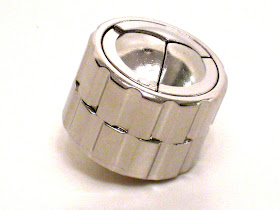Name
CorRECTly In The Bag
Designer
Hirokazu Iwasawa
Mineyuki Uyematsu. Not available currently.
Type & Classification
Put-Together; 3D assembly
Dimensions
Bag - 18.5cm (Length) x 7.8cm (width)
Rectangle - 12cm (Length) x 9 (width)
Materials & Construction
Bag is made of a high quality cloth adorned with a dragonfly motif with a red inner lining. The rectangle is cut from a cross-section of four different woods joined together giving it a very nice checker board finish.
IPP
CorRECTly In The Bag is a variation of Iwasawa's earlier design, the Square In The Bag which won the Puzzlers' Award at IPP32 in Washington, USA last year.
Overview
I like Hirokazu Iwasawa's puzzle designs very much and in fact own two of his metal puzzles, the Alcyl and Tritalon, both reviewed earlier in this blog. I also had the opporunity to meet him at IPP33 in Tokyo, Japan just this August where he was Chairman of the IPP33 Organising Committee.This CorRECTly In The Bag was kindly loaned to me by puzzle collector Lee Yee Dian of Malaysia, who happened to be in Singapore recently. Yee Dian had come with Maki Kaji (the Godfather of Sudoku) who was in town to meet some of the local Mensa club members. It was at this Mensa gathering (no, I am not a member cos I am not that smart!) that I first handled the puzzle. Puzzle designer Goh Pit Khiam was also present and had a bash at the puzzle. At IPP33 I had missed out on buying the puzzle sold by Mineyuki Uyematsu which were all snapped up almost immediately once the Puzzle Party began.
The object of the puzzle is to cover fully the entire rectangle with the cloth bag, leaving no gaps. No force is needed, otherwise the cloth bag may tear. Impossible you might say...and this is what I though too when I first looked at the puzzle. It looked like an impossible object at first glance.
I fiddled with the puzzle for quite a while before stumbling on the solution. This is one of those puzzles that give you the A-ha rush feeling once you solve it. The bag can and does cover the whole rectangle; really quite amazing! Even a few of the Mensa members couldn't quite figure out the solution. And these are folks that have an IQ of above 148.
What was even more surprising was that when I got home and showed my wife the puzzle and asked her to try it, she solved it in under five minutes while I went to take a shower. When I got out of the bath, the rectangle was all covered up sitting on the coffee table, with my wife giving me that nonchalant "its-really-no-big-deal" look. Or is it because women know some things about fabric while we men don't. Maybe we puzzlers just think too much while puzzling, that's why some of us (like moi) take ages to solve puzzles, or worse still, need to refer to the solution.
Difficulty Level
Not unduly difficult but provides a very good challenge. Given enough time, however you will eventually figure it out.
Whether its the CorRECTly In The Bag or Square In The Bag, it really is a very clever design, using non-traditional materials. The very fact that it looks so innocuously simple and the solution is so elegant truly makes this a very unique and wonderful puzzle.
I have heard that people who can't get their hands on this puzzle have resorted to making it themselves. Not difficult I would imagine so long as you have the right dimensions (see mine above but don't blame me if it doesn't turn out right). Also, access to a good seamstress. And for the rectangle (which can be substituted with acrylic or some other easily obtainable material). You may want to contact fellow blogger Roxanne Wong who has blogged about the Square version and has the specs for you to self-make one.
Personally I am considering making myself one as well since I would have to return the puzzle to Yee Dian the next time we meet. Hmm...let me see, how about 6061 Aluminium for the rectangle and calf leather for the bag...now wouldn't that be quite cool!










